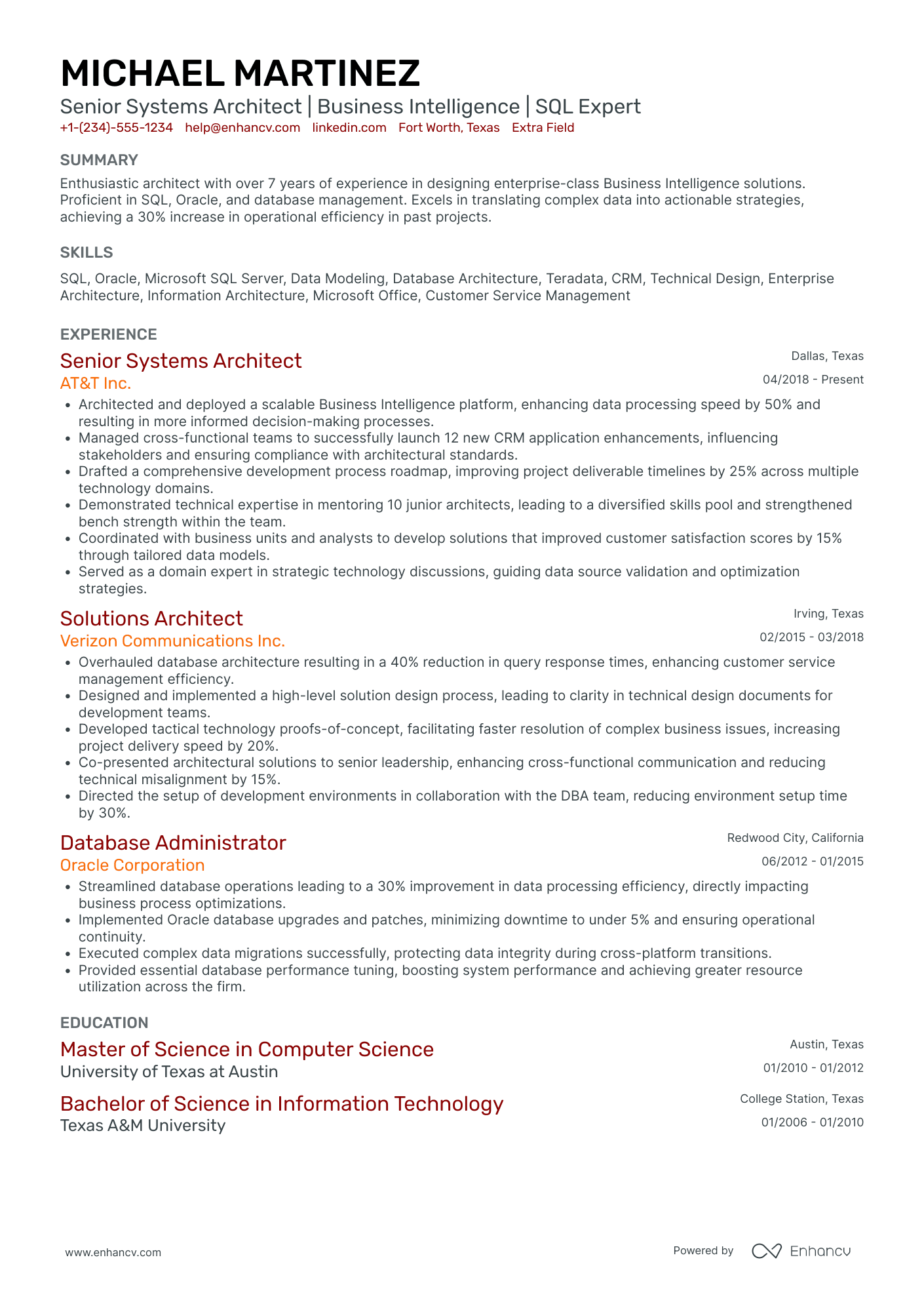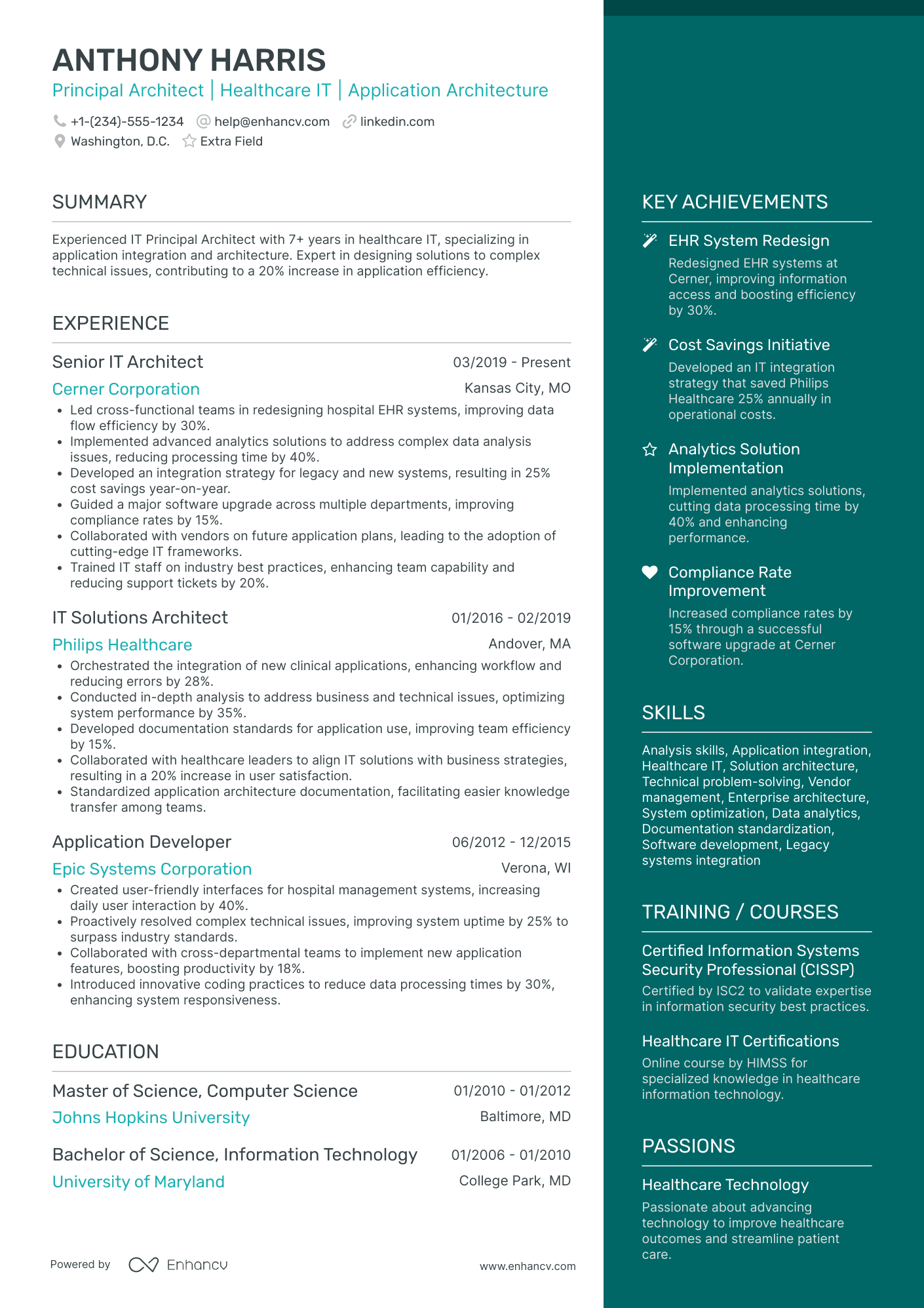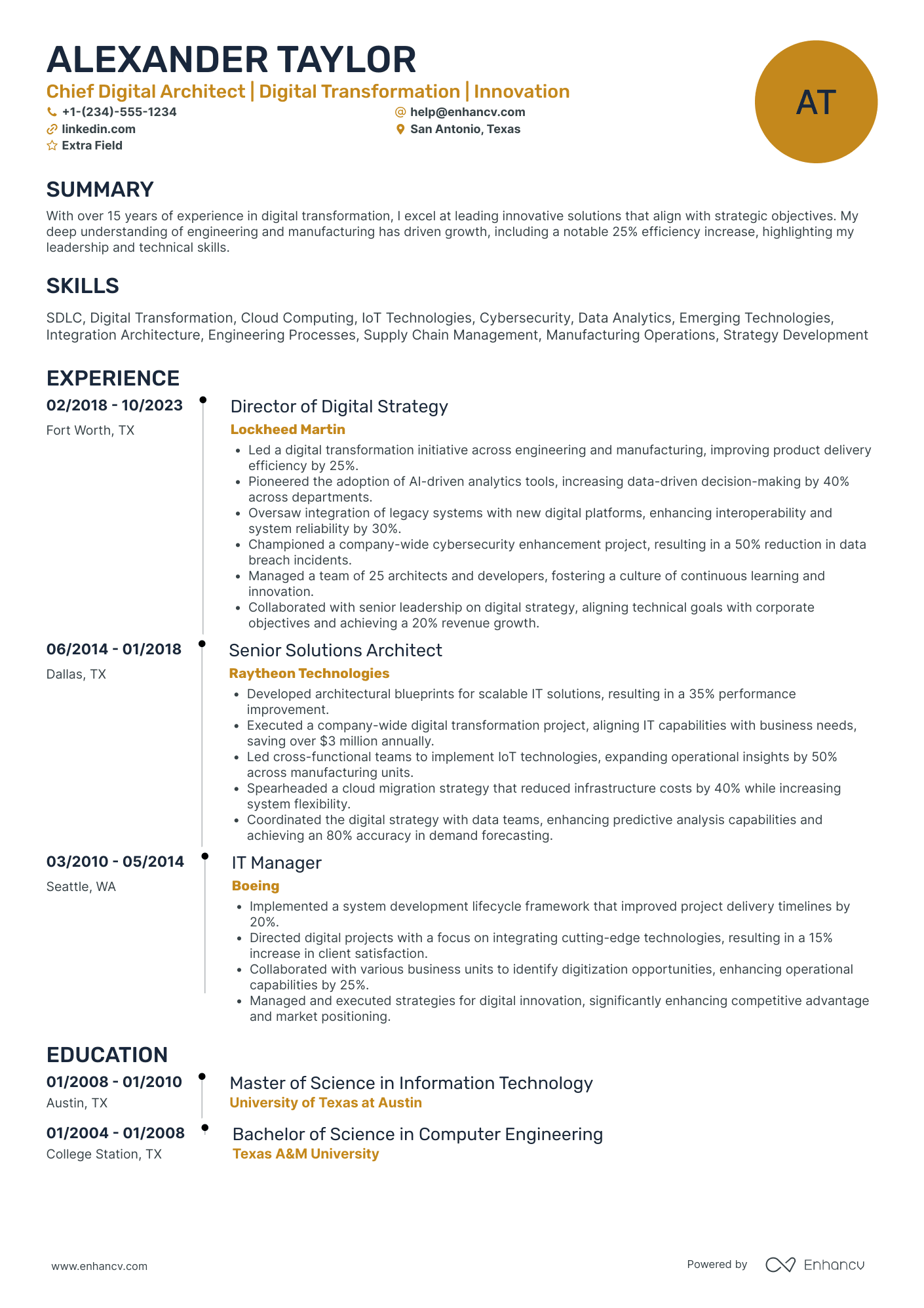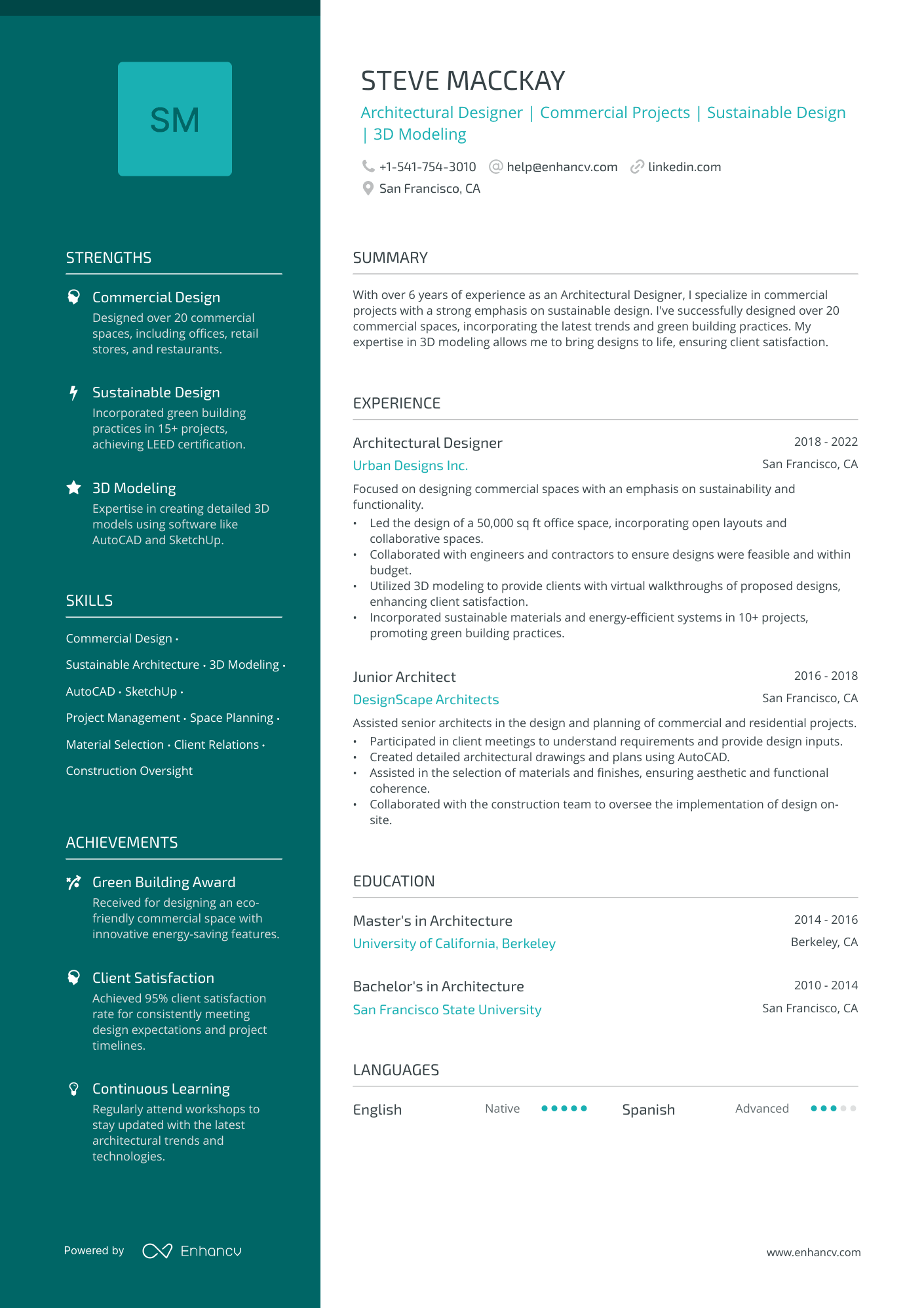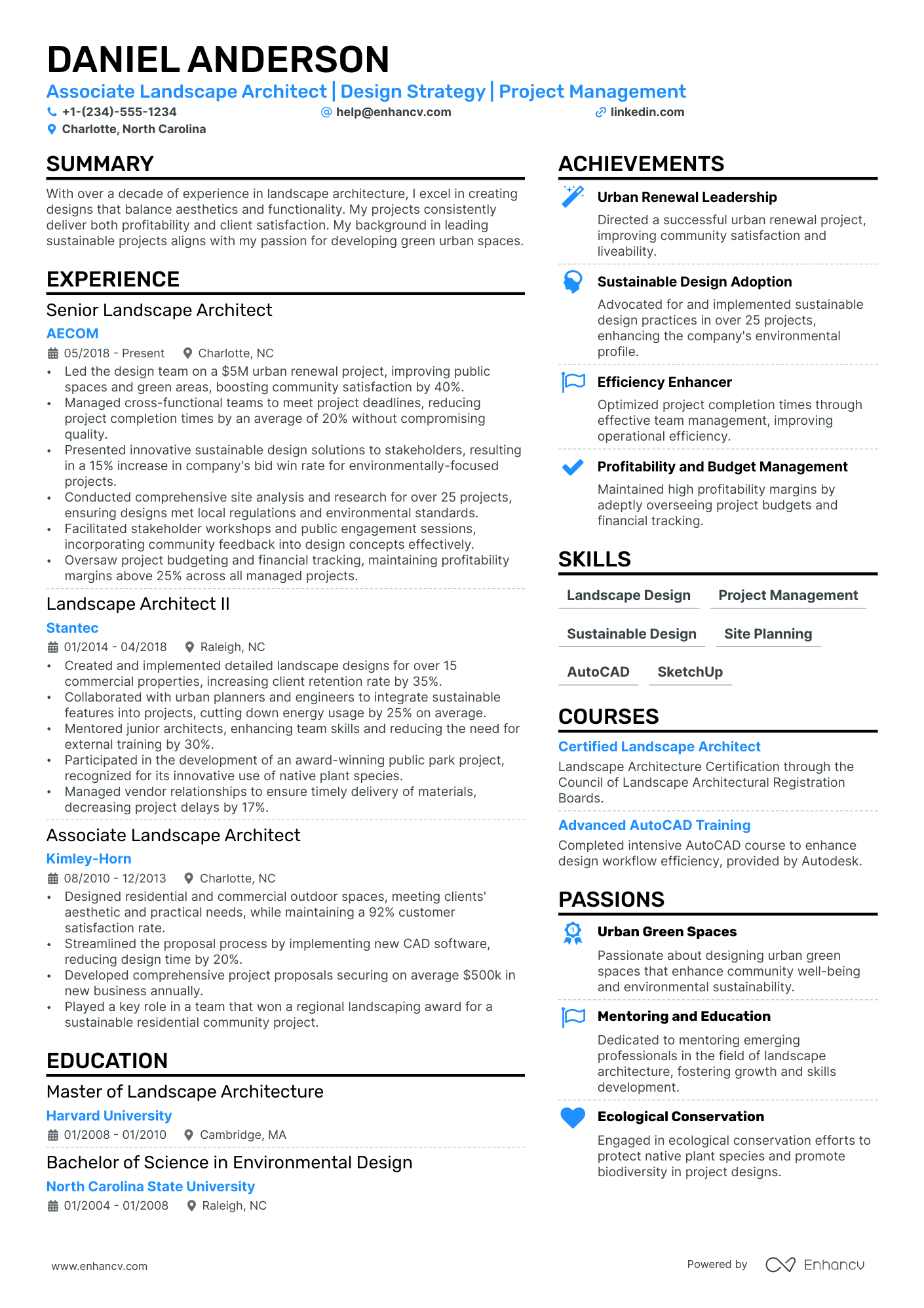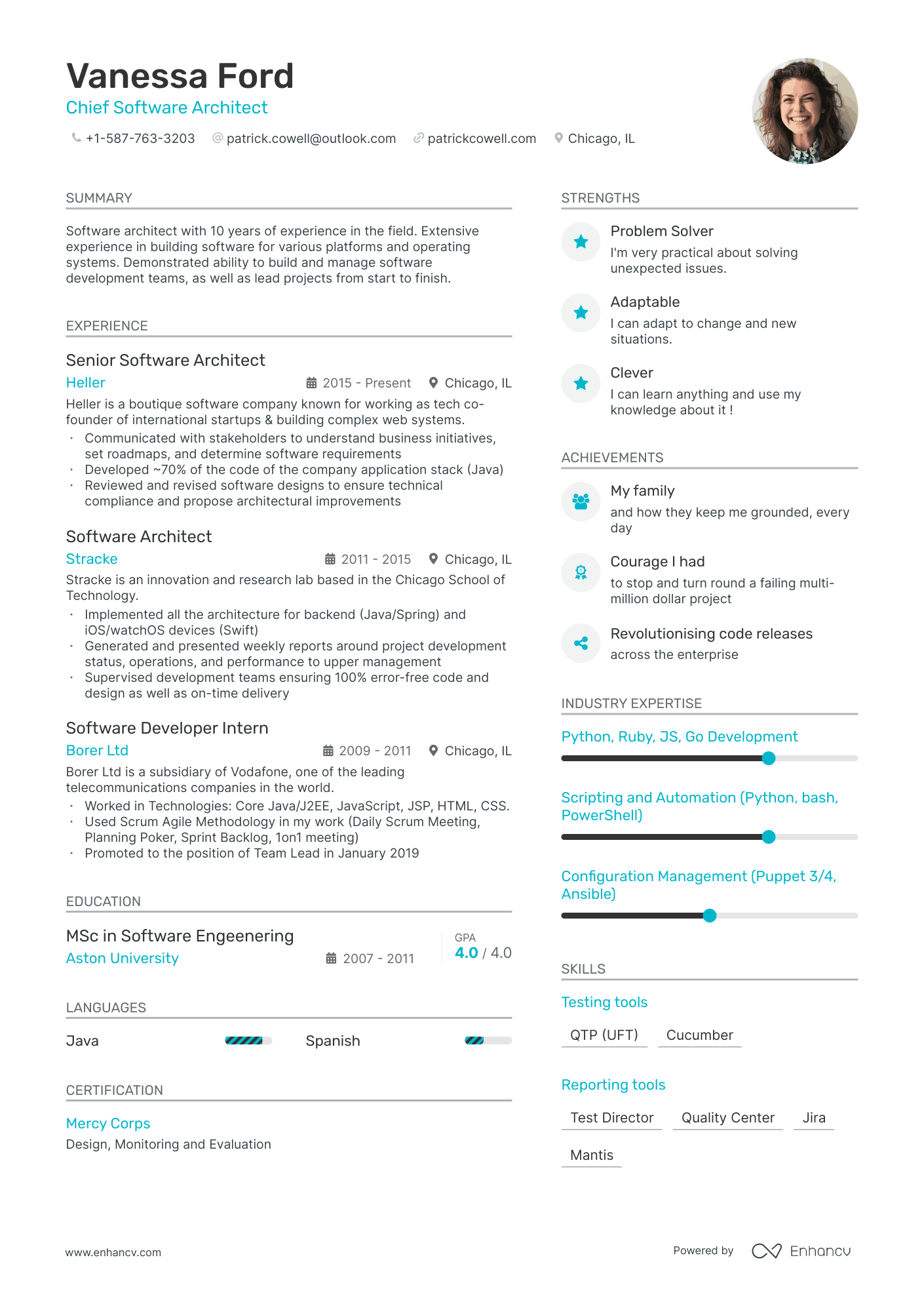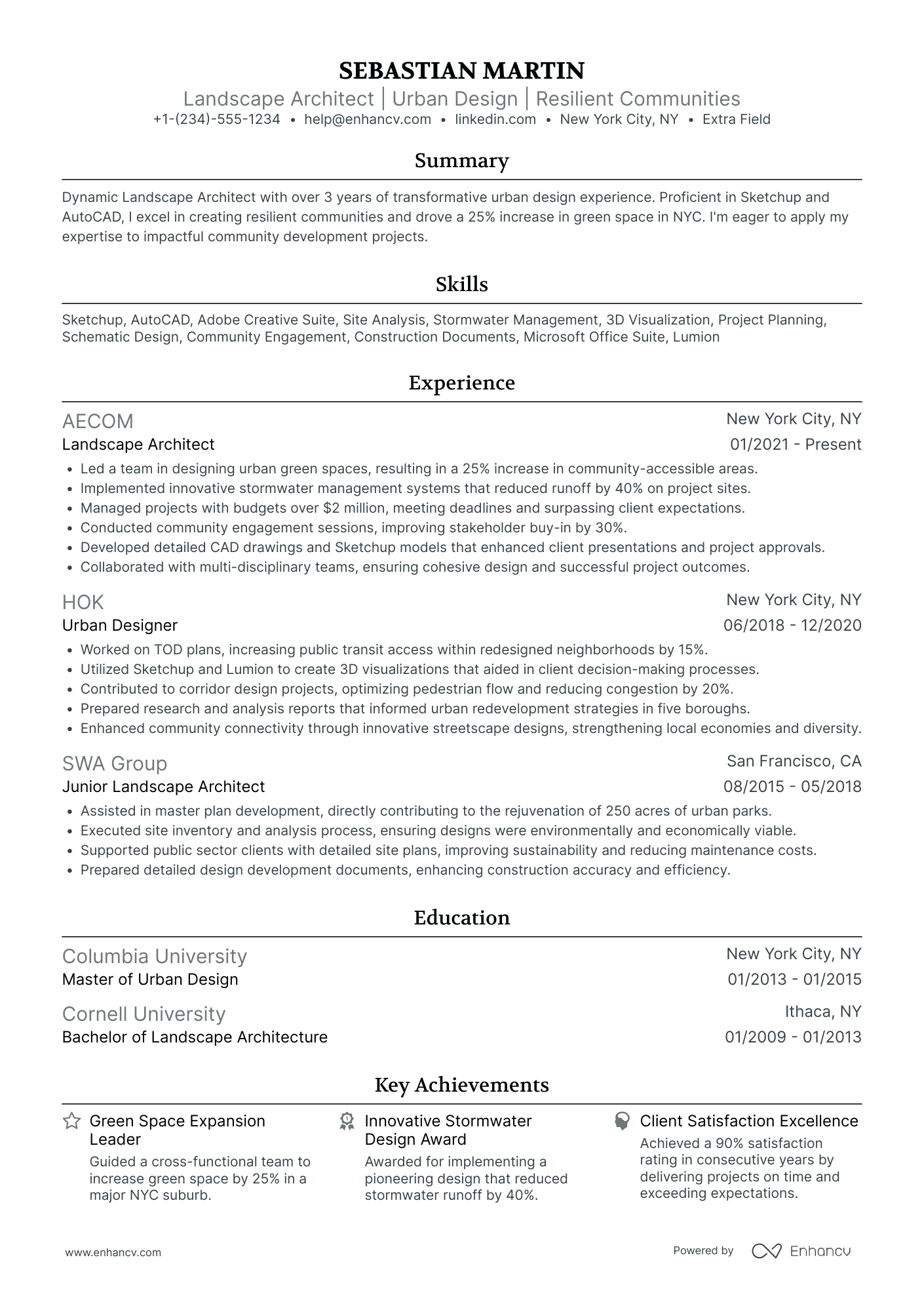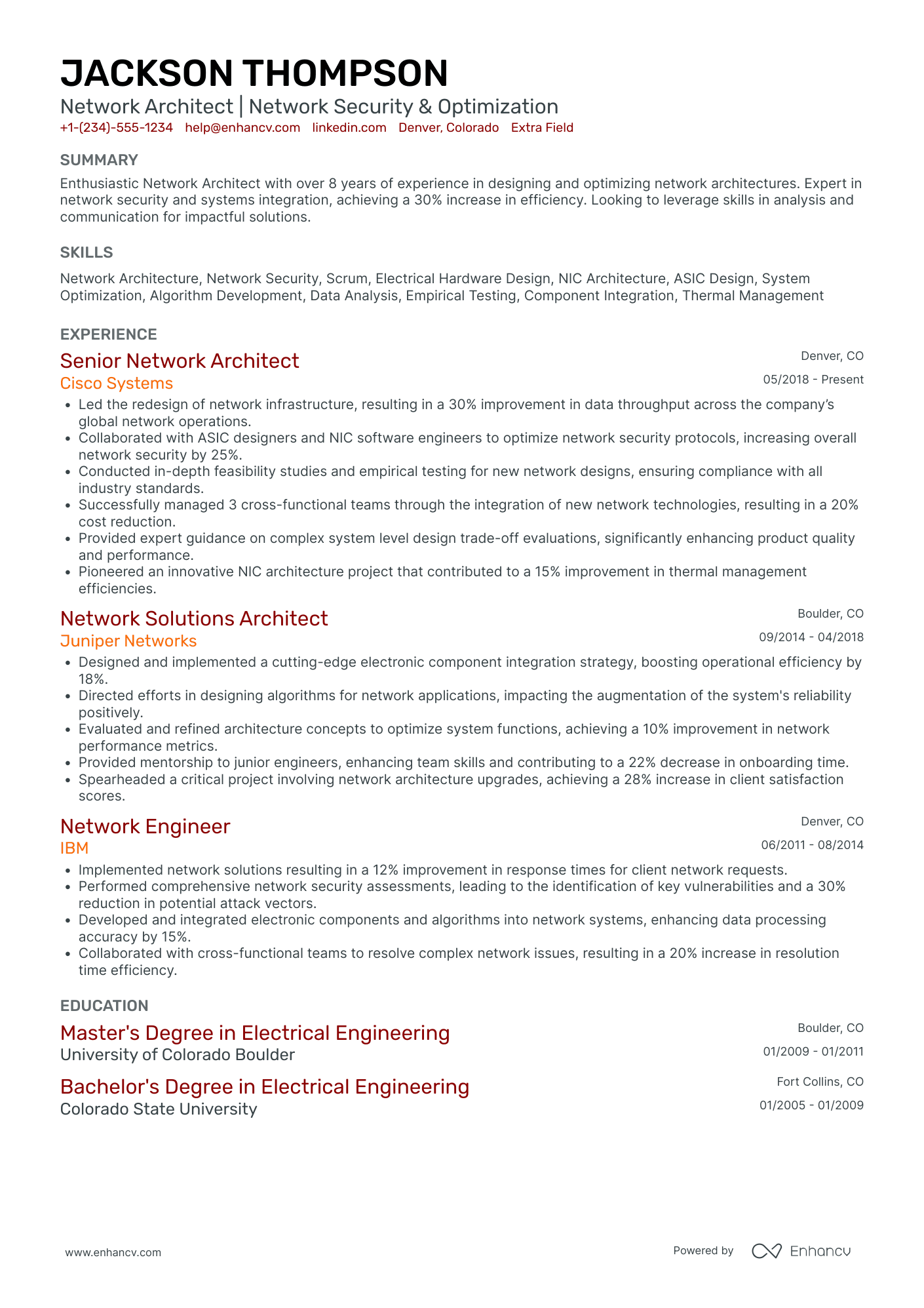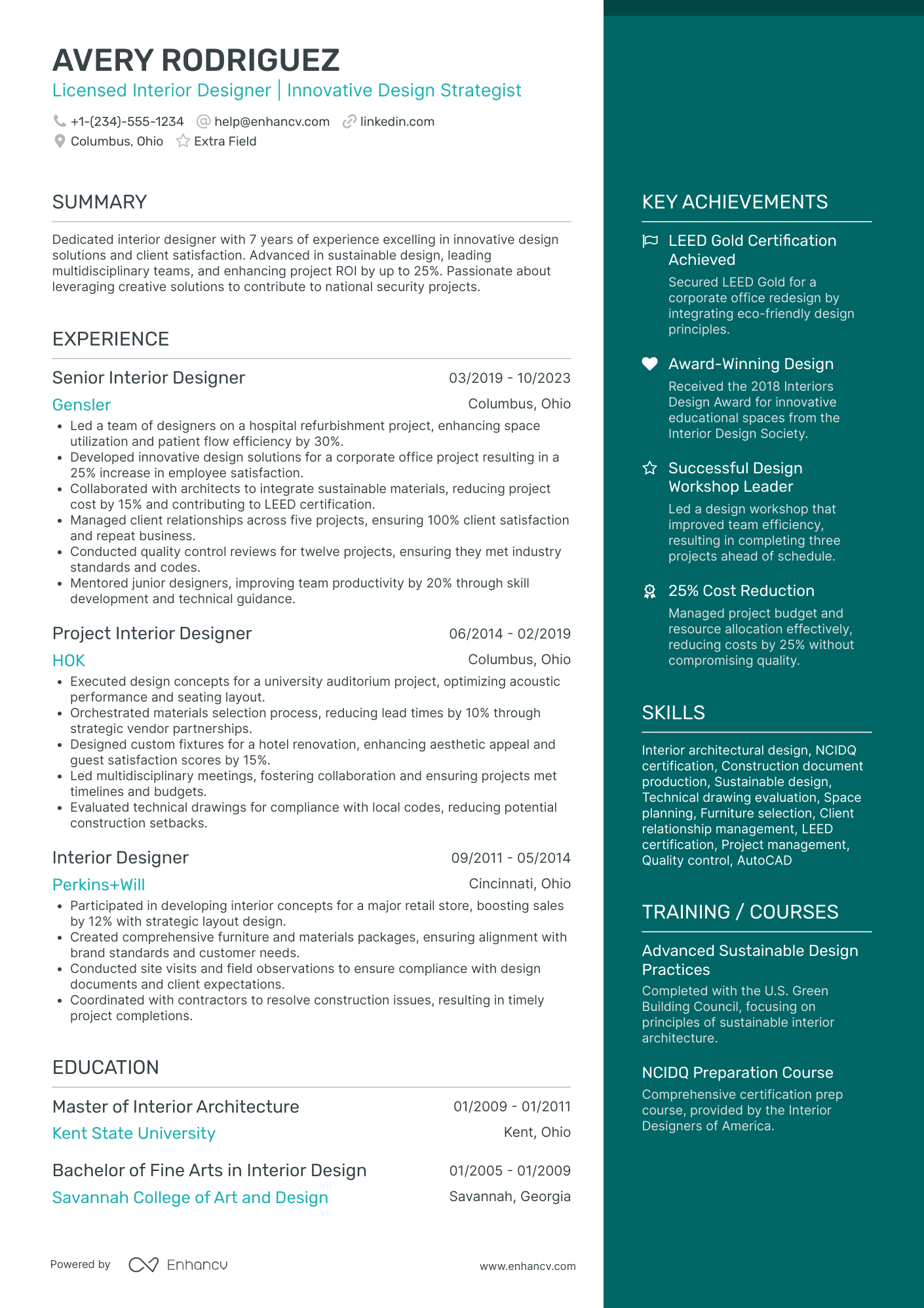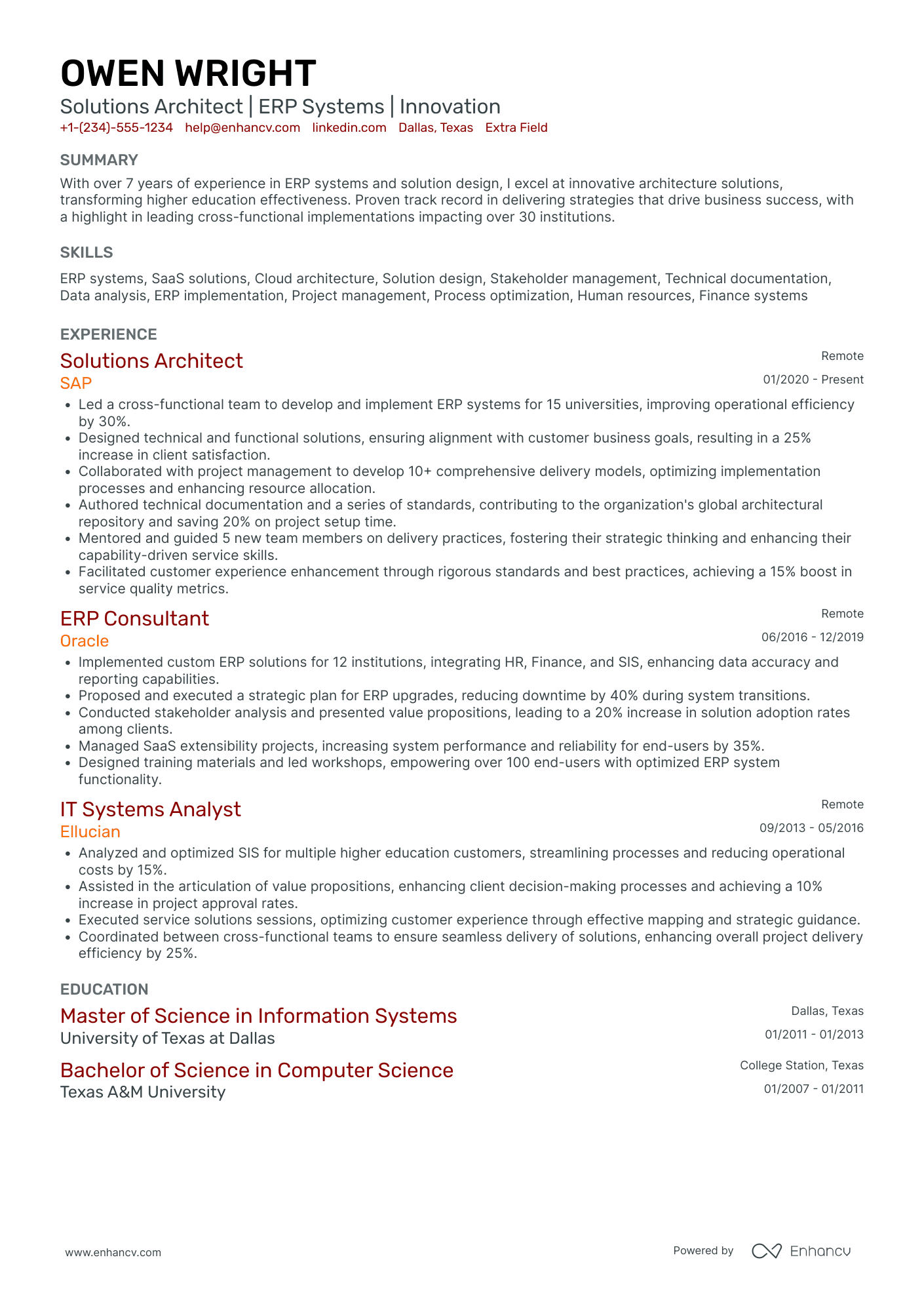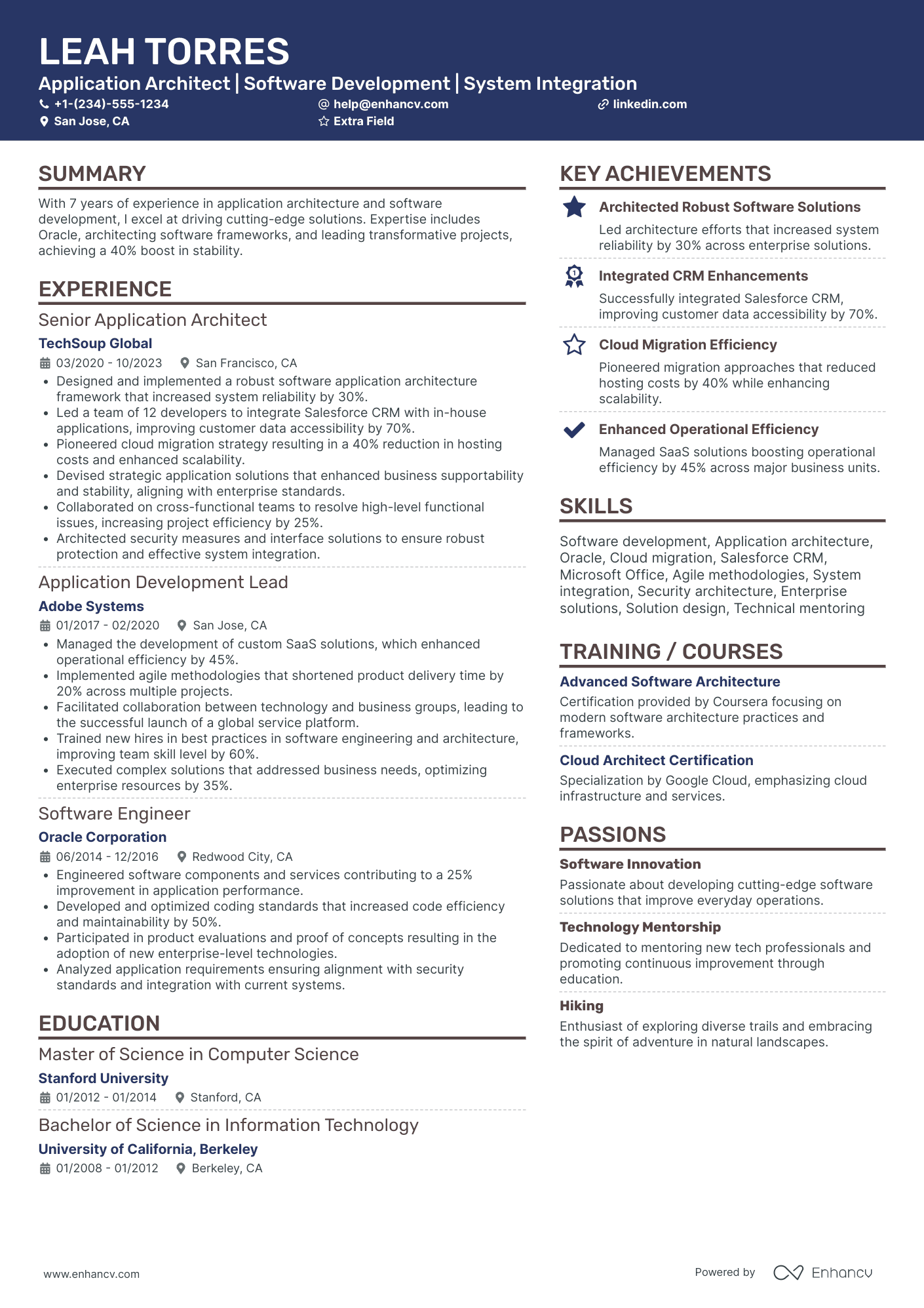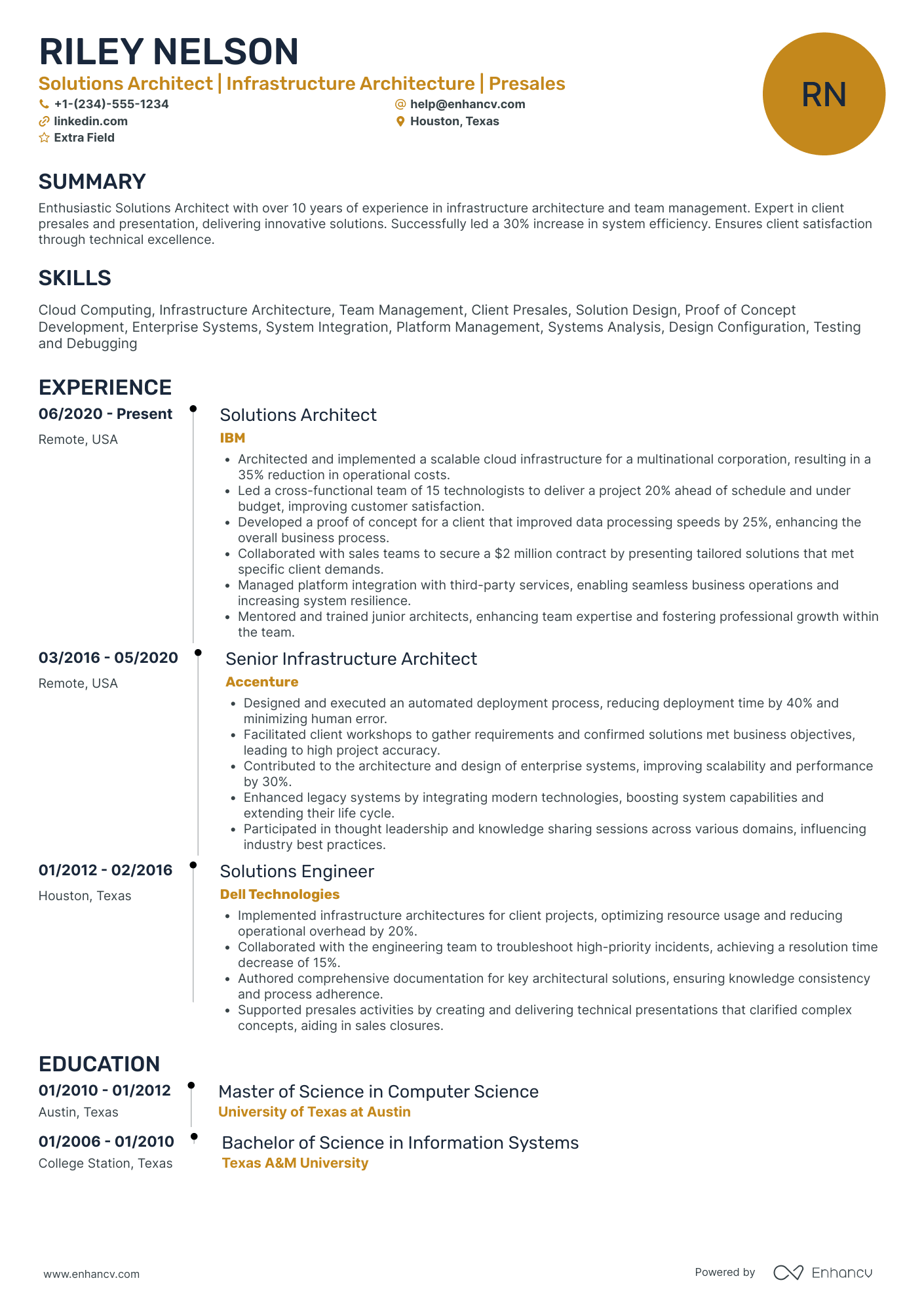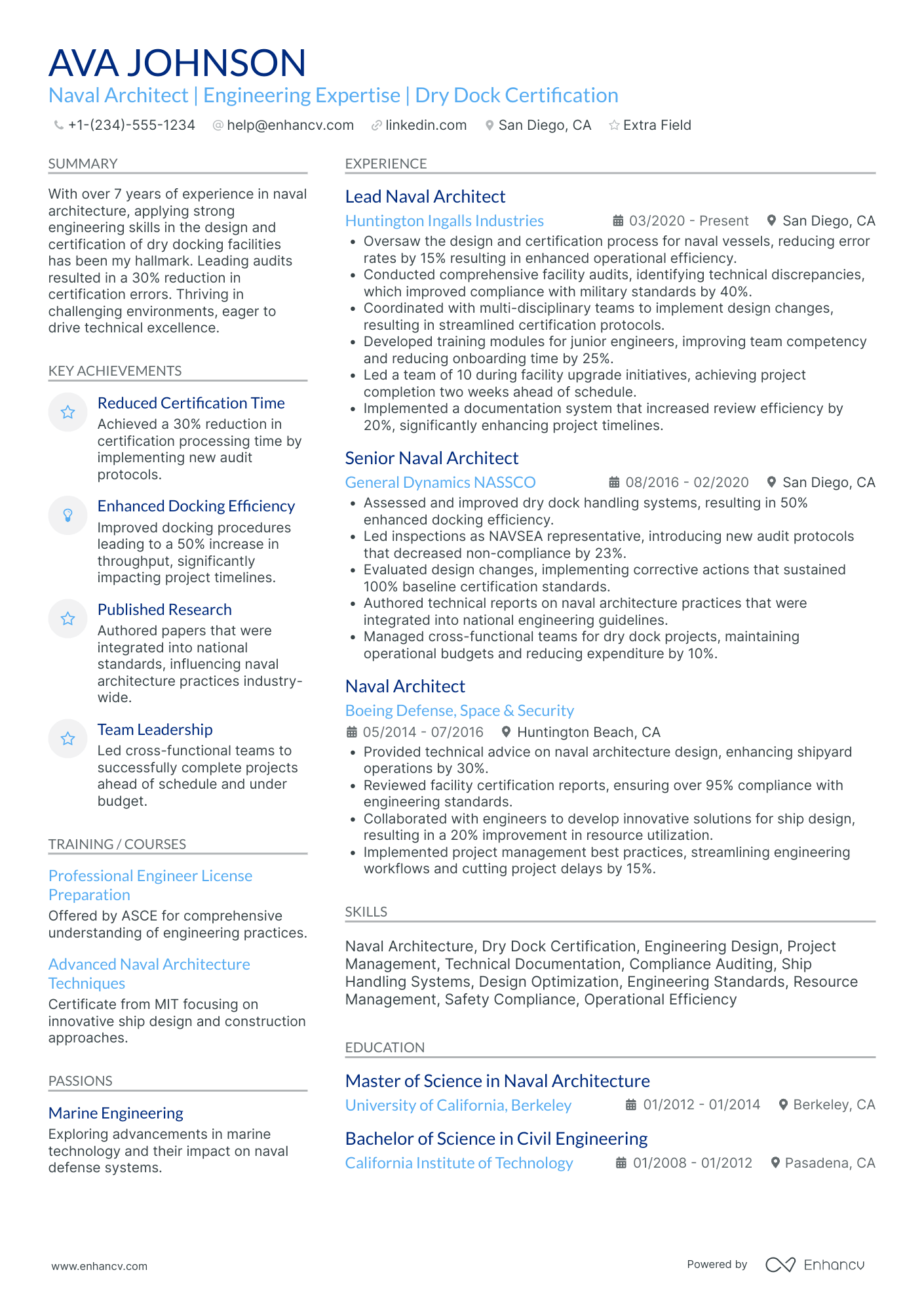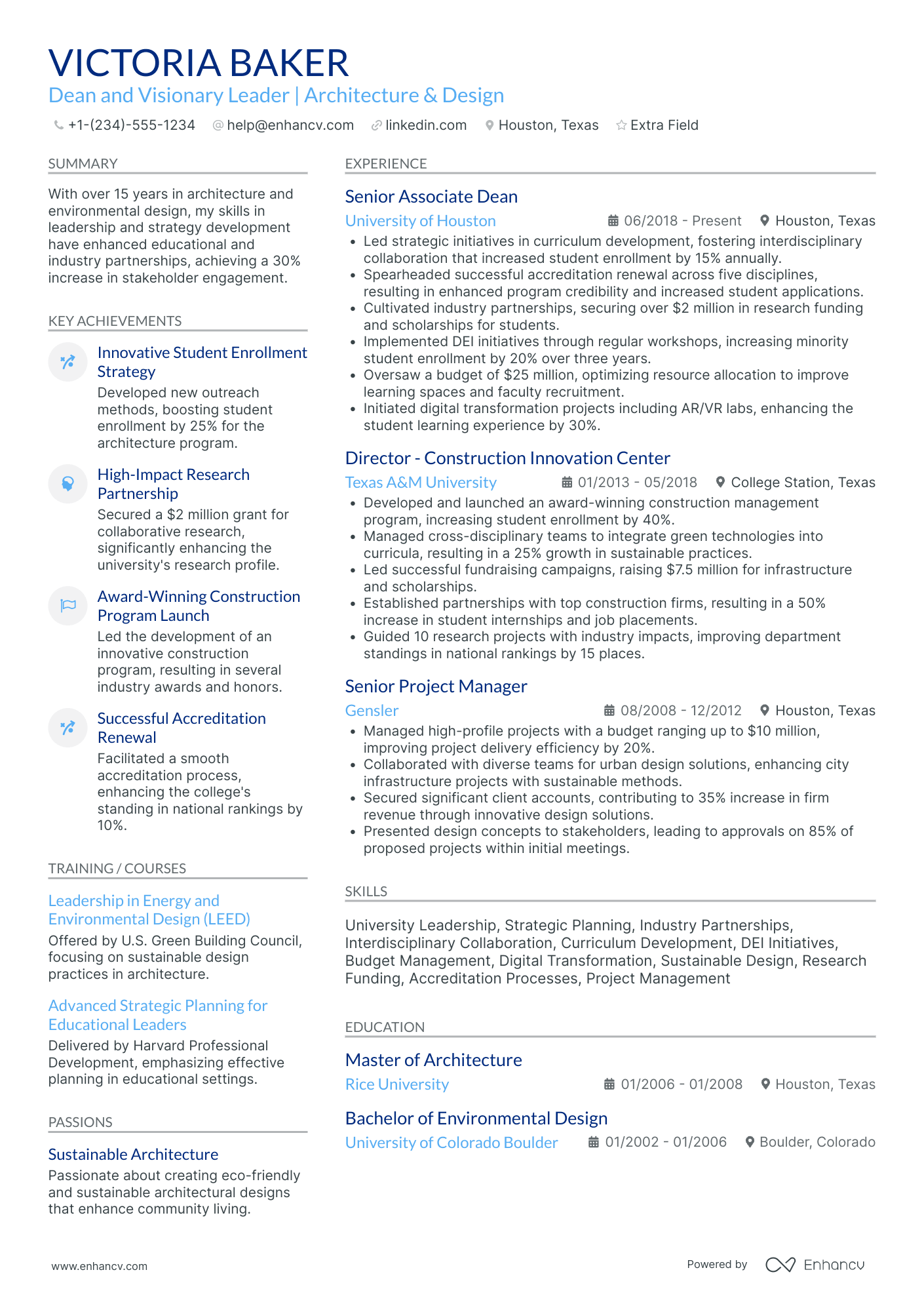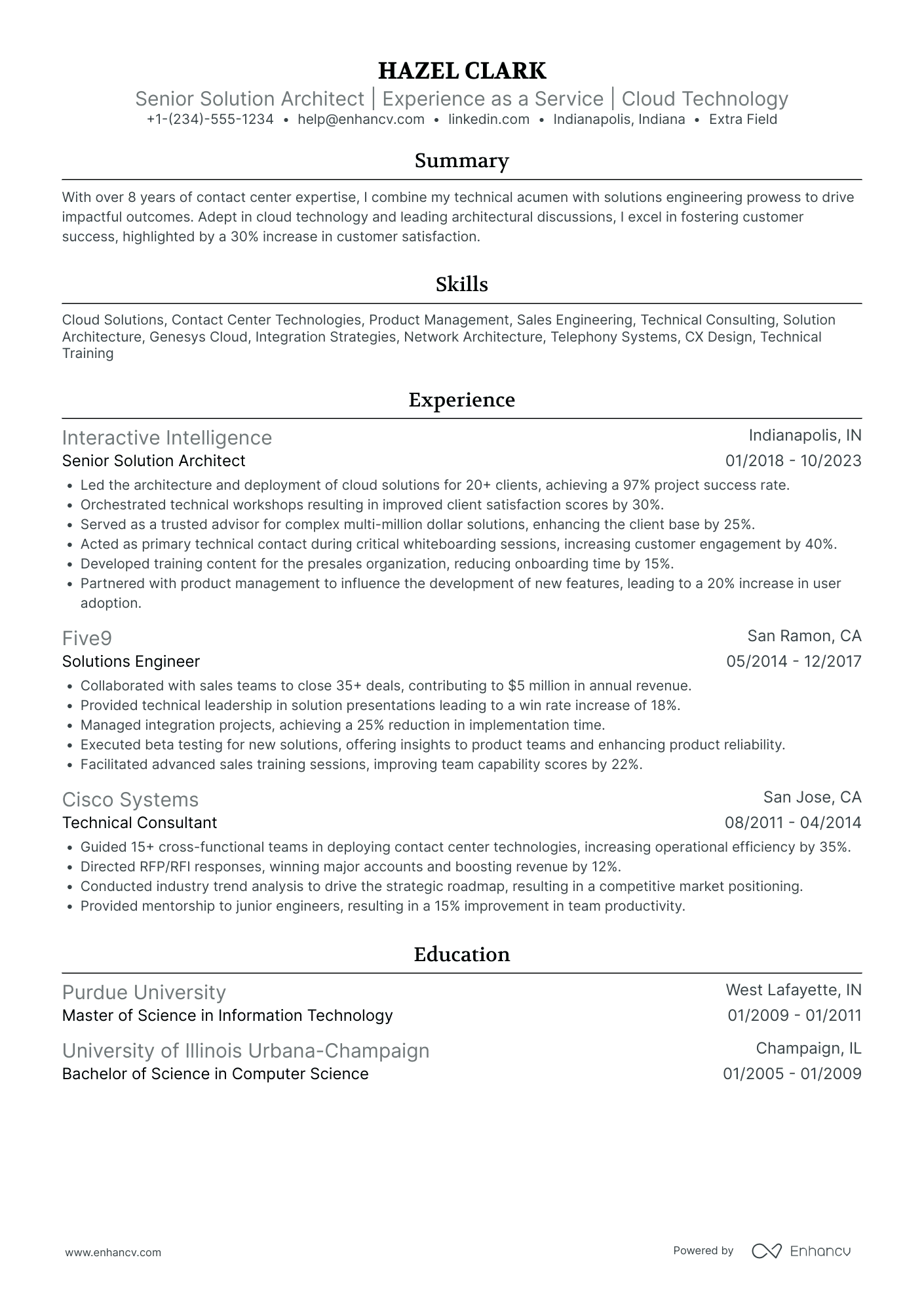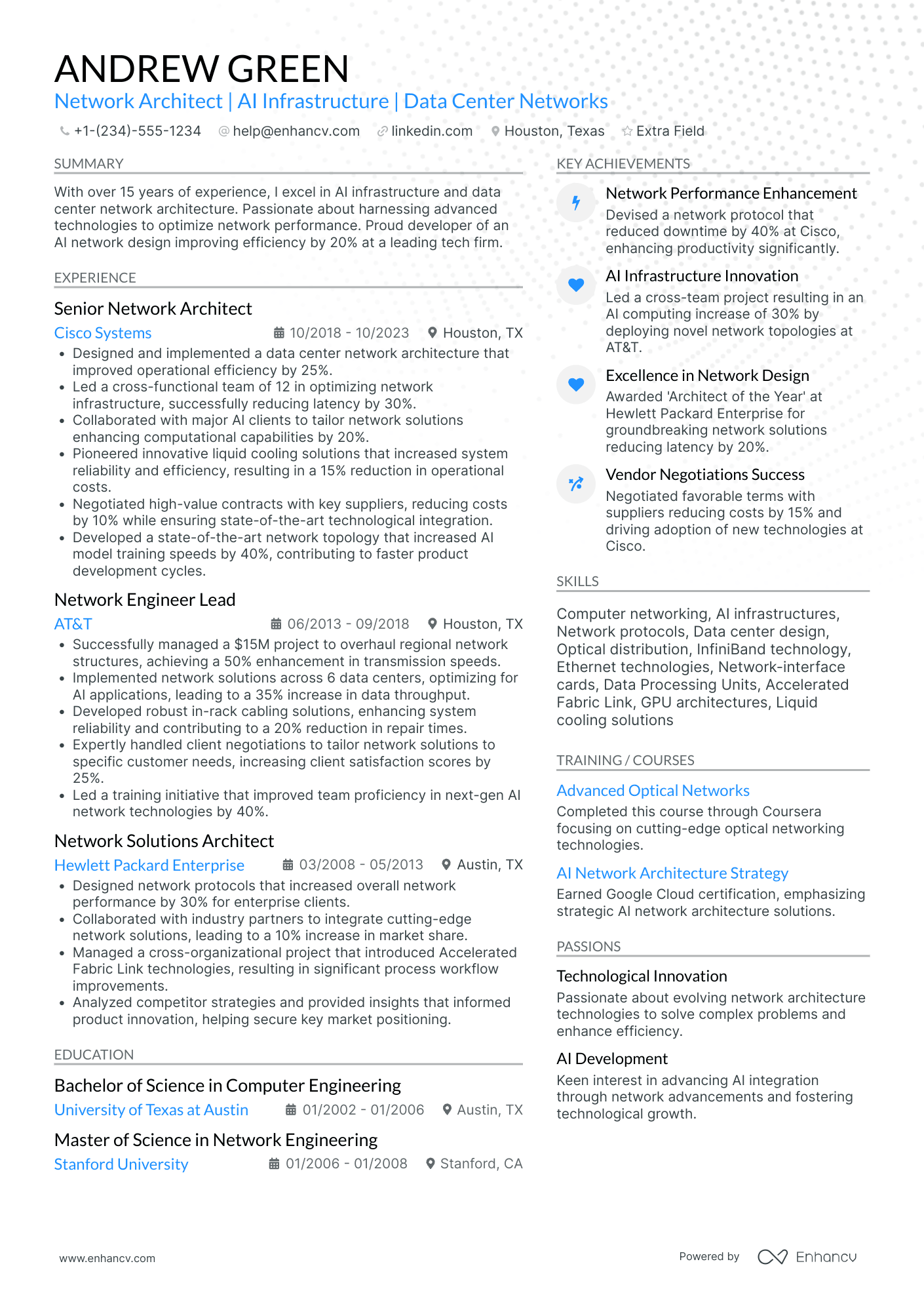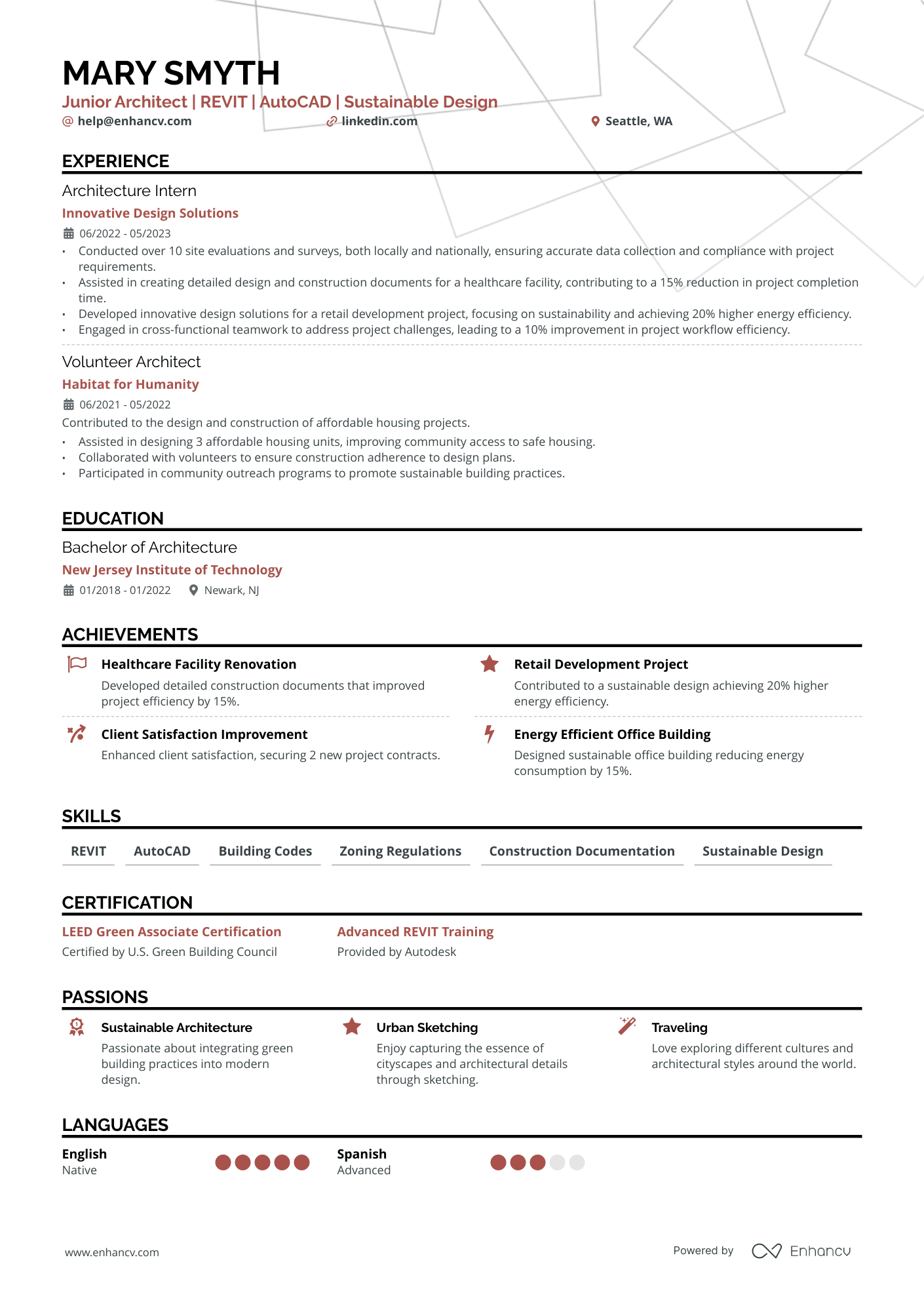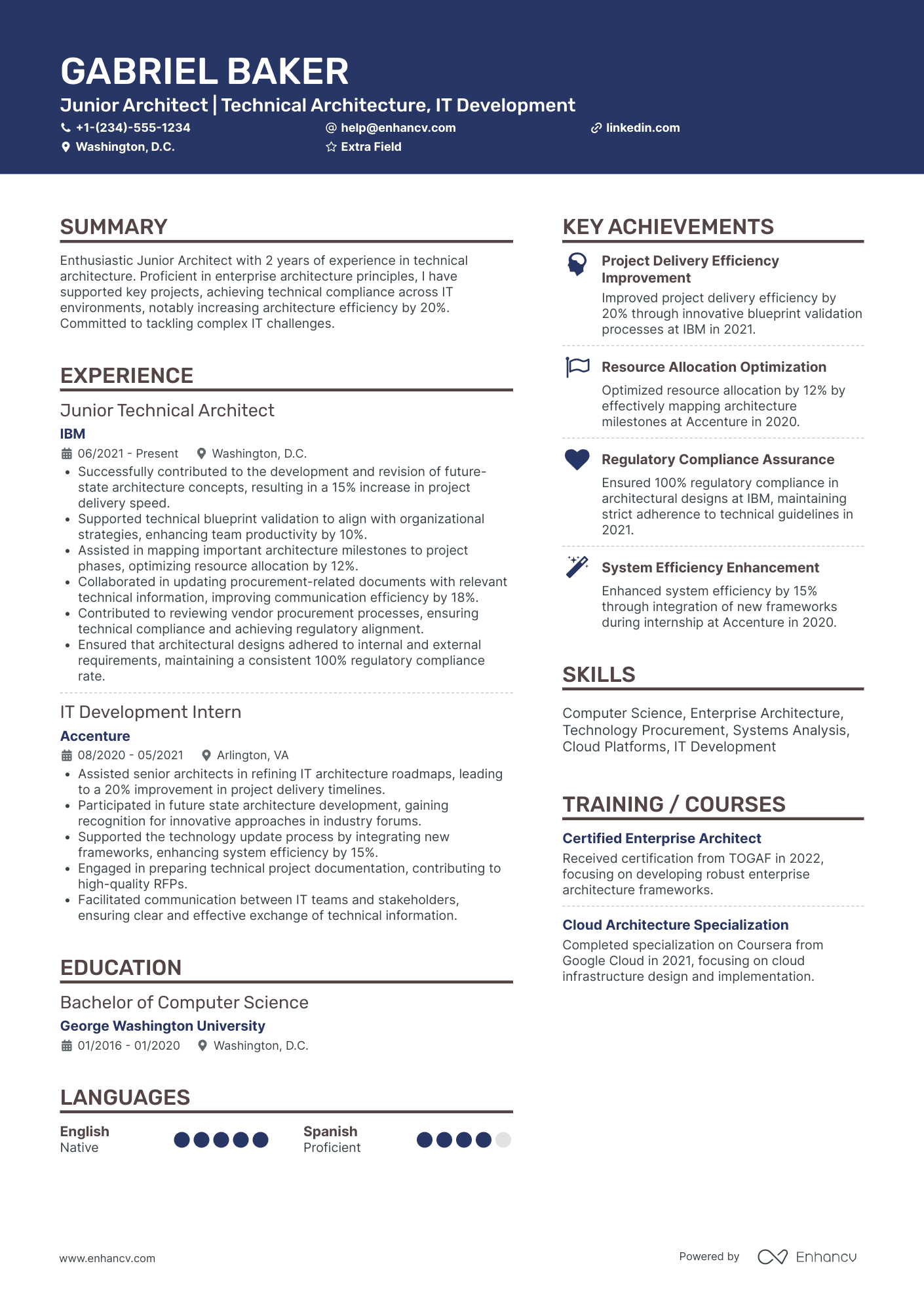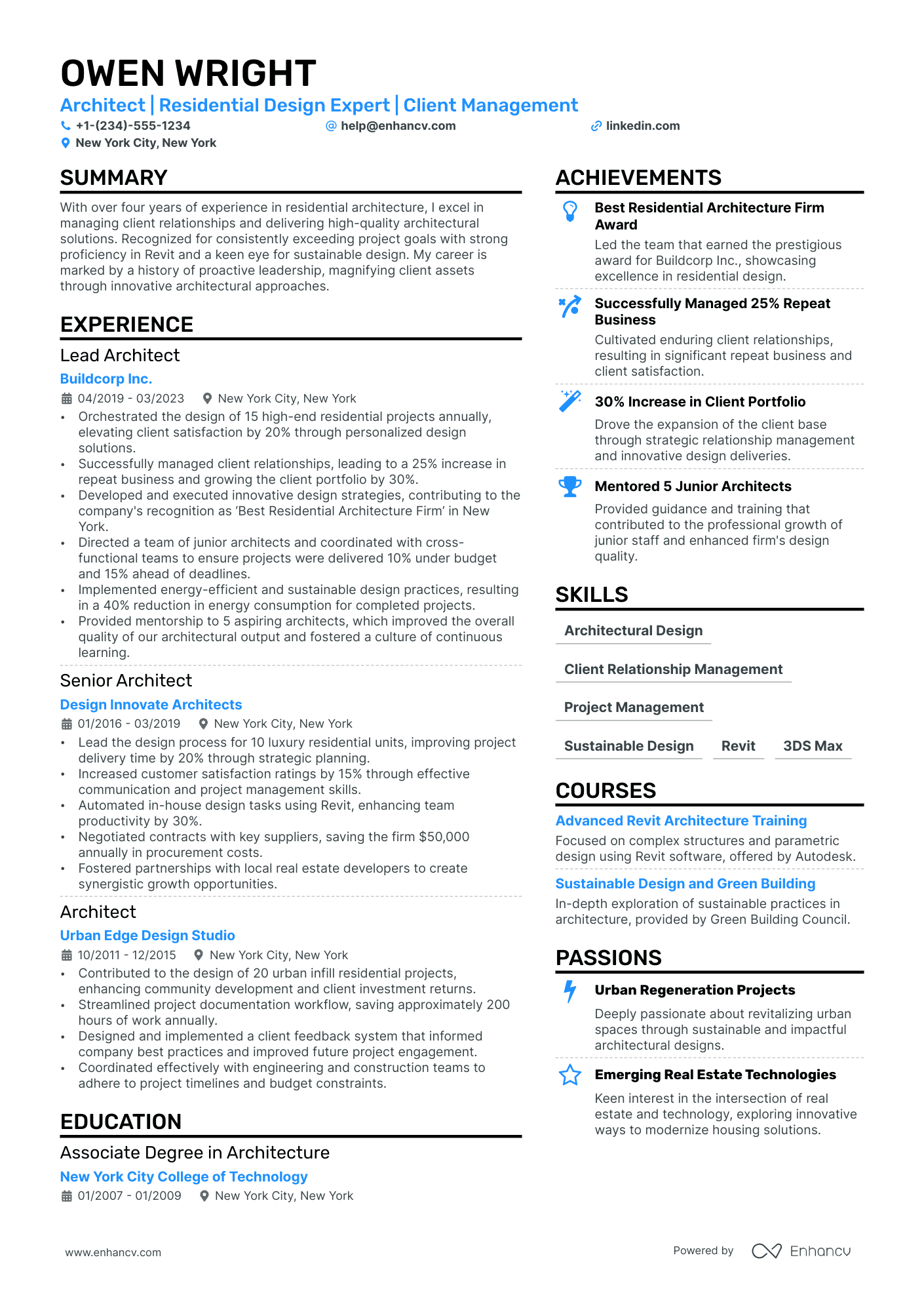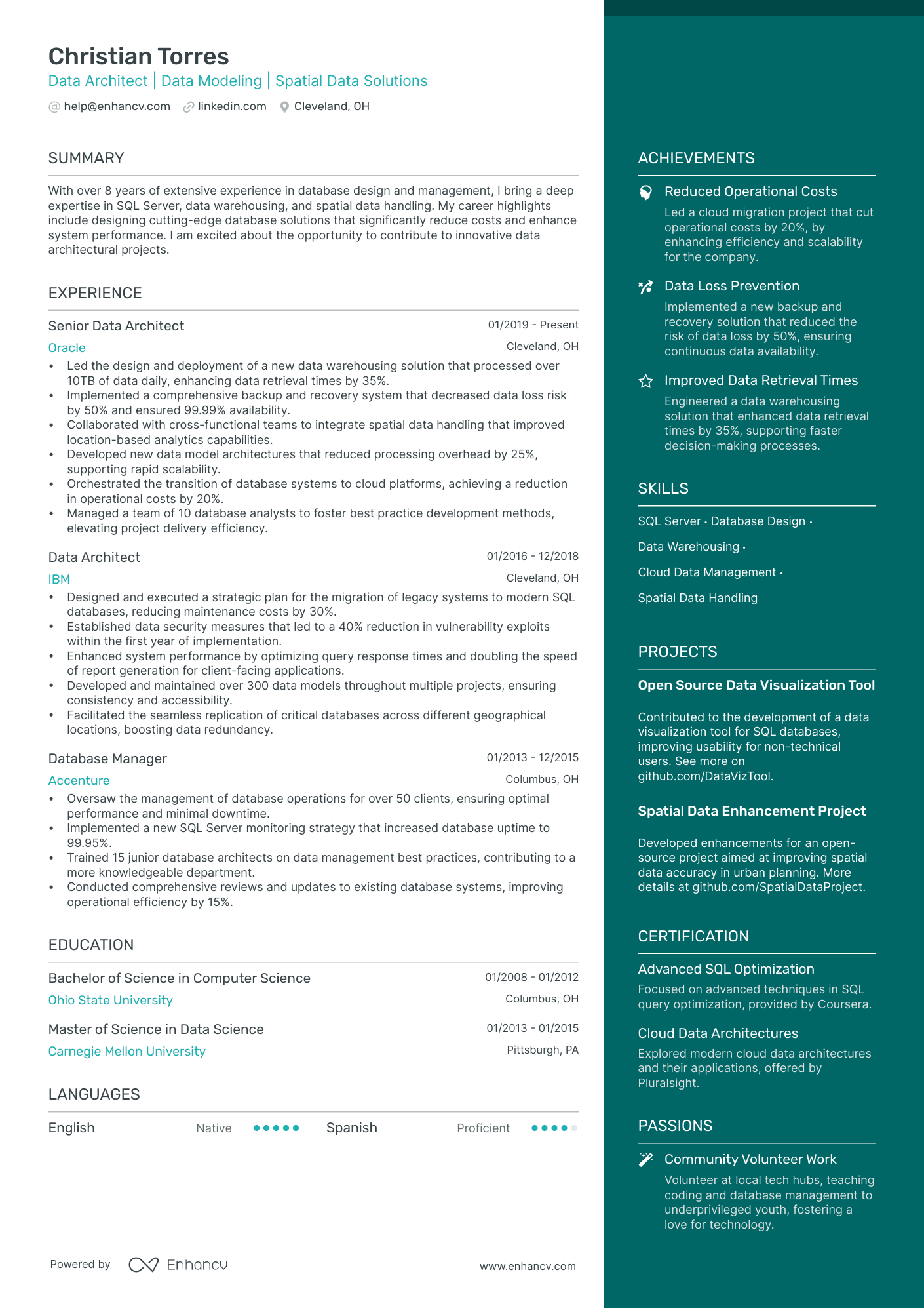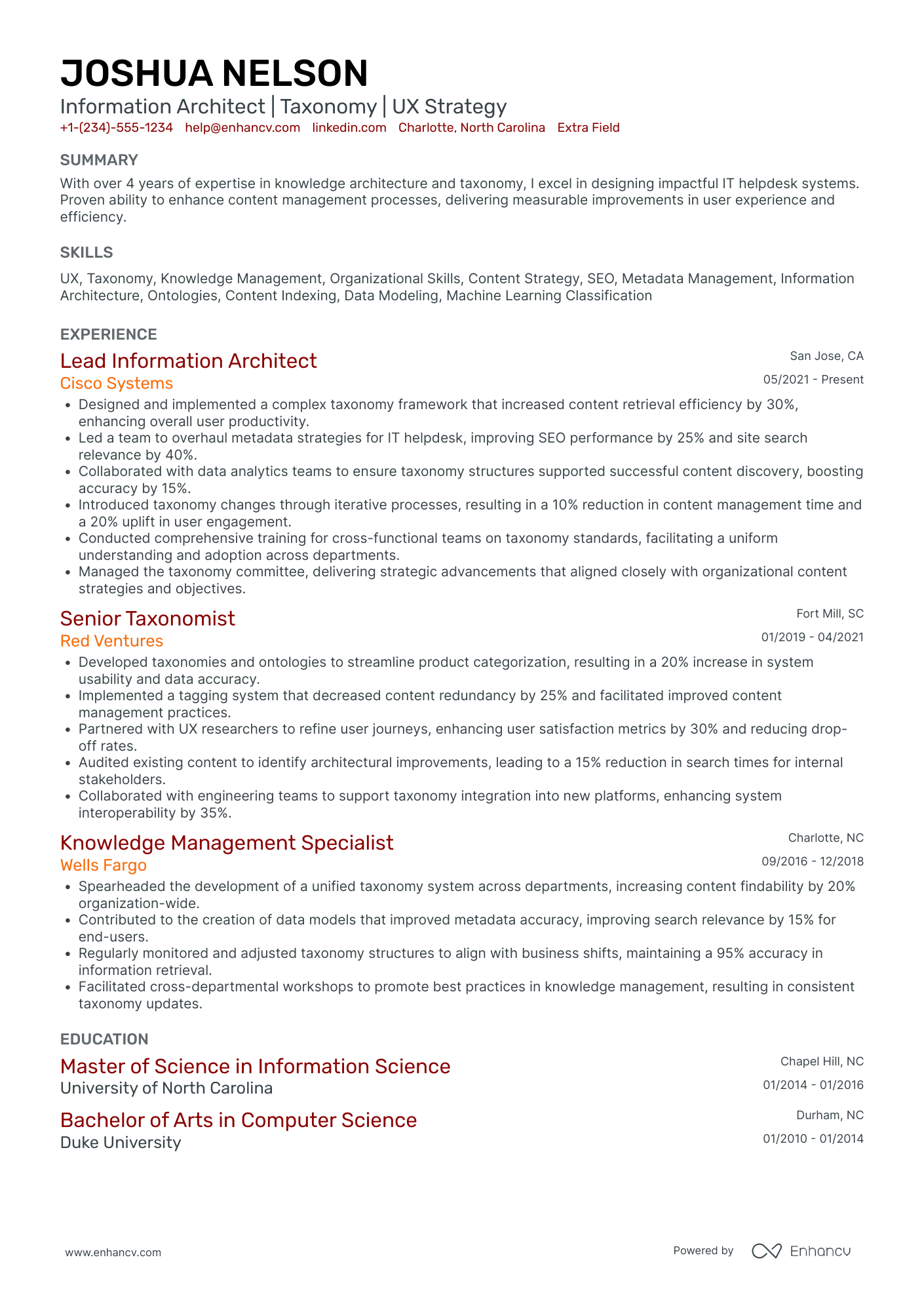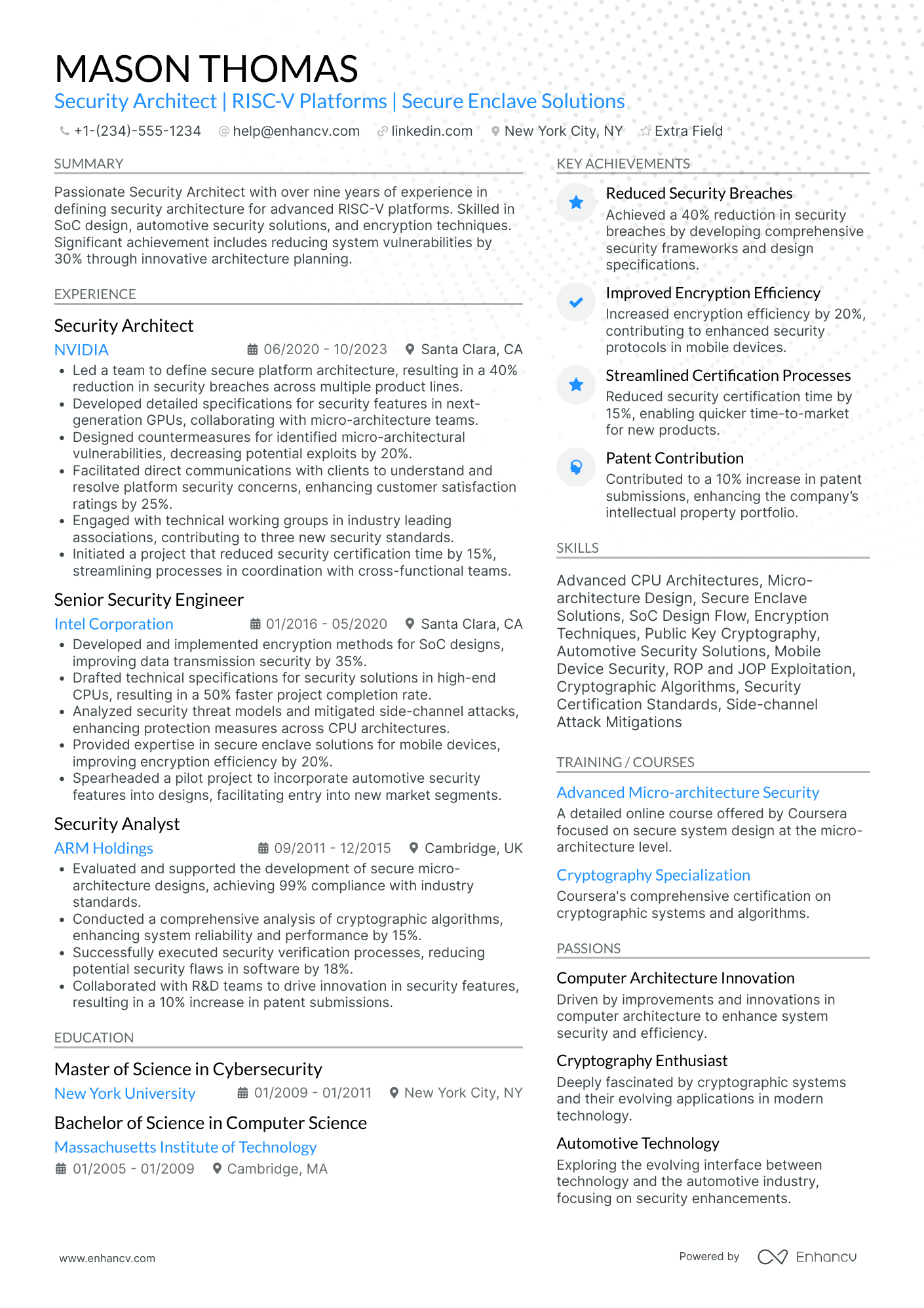Frank Lloyd Wright wisely said, "Form follows function—that has been misunderstood. Form and function should be one, joined in a spiritual union." This principle applies perfectly to crafting your resume. Just as a well-designed building merges beauty and utility, your resume should blend clarity and content seamlessly.
A clear and readable resume is essential in today's competitive job market. Think of it as the blueprint of your career: meticulously planned, visually appealing, and easy to navigate. A cluttered resume can obscure your talents, just as a messy blueprint can lead to construction errors.
In this guide, we'll help you design a resume that highlights your architectural skills with elegance and precision. Here’s what we’ll cover:
- The best resume formats tailored to the needs of both junior architects and senior partners.
- Creating a targeted experience section filled with keywords from the job description.
- The most sought-after skills and specializations in today’s architecture landscape.
- Real-world architect resume examples that you can adapt for your own application.
- Including crucial certifications and licenses to easily pass ATS screens.
- Writing a compelling architect summary that will secure you a job interview.
Before we dive in, you might want to have a look at some other architecture and engineering resume guides:
- Architecture Student Resume Example
- Architecture Intern Resume Example
- Architectural Designer Resume Example
- Freelance architect Resume Example
- Civil Engineer Resume Example
- Structural Engineer Resume Example
- Architectural Project Manager Resume Example
- Landscape architect Resume Example
- Construction Manager Resume Example
- Construction Worker Resume Example
- Architect Cover Letter Example
Architect resume sample
Here’s an example architecture resume that you can adapt to your own needs. With the Enhancv resume builder, you can have it done within a few minutes.
Jane Doe
Project architect
janedoe@email.com | Portfolio: janedoeportfolio.com | Seattle, WA |
Professional summary
Creative and highly skilled Project architect with over 6 years of experience in waterfront residential design, commercial, business interiors, and mixed-use projects. Known for innovative design solutions and a passion for high-quality, client-focused architecture. Proficient in CAD systems, including Vectorworks and ArchiCad. Demonstrated ability to lead projects from concept to completion while exceeding client expectations.
Professional experience
Senior Project architect
ABC architects Seattle, WA
June 2018 - Present
- Lead design and development of commercial and residential projects, specializing in mixed-use and urban dwellings, successfully completing over 20 projects.
- Collaborate with clients to develop innovative design solutions, achieving a 95% client satisfaction rate and securing 15% repeat business annually.
- Oversee project lifecycle from conceptual design through construction administration, ensuring 98% adherence to budget and timelines.
- Mentor junior architects, improving team productivity by 20% and maintaining company standards of design and professionalism.
Project architect
XYZ Design Studio Bremerton, WA
May 2016 - May 2018
- Designed and coordinated waterfront residential and commercial projects, contributing to downtown revitalization efforts.
- Utilized Vectorworks and ArchiCad to create detailed architectural drawings and 3D models.
- Managed client relationships, ensuring clear communication and successful project outcomes.
- Developed and presented design concepts to clients and stakeholders, receiving positive feedback and approval.
Education
Master of architecture (M.Arch)
University of Washington, Seattle, WA
Graduated May 2016
Bachelor of Science in architecture (B.Sc. Arch)
University of Washington, Seattle, WA
Graduated May 2014
Certifications and licenses
- Licensed architect, State of Washington
- LEED Accredited Professional
Skills
- Design: Waterfront residential design, commercial design, mixed-use projects, urban dwellings, business interiors
- Technical: CAD (Vectorworks, ArchiCad), 3D modeling, building codes and regulations
- Professional: Client relations, project management, team leadership, innovative design solutions, high-quality design standards
- Communication: Excellent verbal and written communication, client presentations, stakeholder engagement
Professional affiliations
- American Institute of architects (AIA)
- National Council of architectural Registration Boards (NCARB)
- US Green Building Council (USGBC)
Awards
- AIA Seattle Honor Award, 2022
- Bremerton Downtown Revitalization Project Award, 2021
Projects
Downtown Bremerton Revitalization
June 2018 - October 2018
- Lead architect for mixed-use development, combining retail spaces with residential units to enhance urban living.
How to format an architect resume
The first and most critical rule about creating an architecture resume is keeping it concise and to the point. It’s not a cover letter and it’s certainly not an autobiography—а resume is just one page long.
Even senior architects with decades of experience, dozens of buildings, and a handful of awards to their names have one-page-long resumes.If you’re Le Corbusier, you might get away with a second page, although he wouldn’t need one.
To fit as much information as possible while keeping your resume clear and readable, consider using one of the three most common formats:
- Reverse chronological resume: It lists your work history in reverse chronological order, starting with your most recent position. This format’s ideal for those with a steady career progression and significant experience in the field. It highlights your career growth and key roles in various projects.
- Functional (skills-based) resume: It focuses on your skills and areas of expertise rather than your work history. Perfect for recent graduates, career changers, or those with gaps in their employment, it emphasizes your architectural skills, software proficiency, and specific project experiences.
- Combination (hybrid) resume: This one blends elements of both chronological and functional formats, showcasing your skills while providing a brief overview of your work history. It’s suitable for candidates with diverse experience and significant accomplishments. It allows you to highlight key skills and notable projects while also demonstrating your career trajectory.
Adjust your resume layout based on the market – Canadian resumes, for example, may follow a unique format.
The fundamental failure of most graphic, product, architectural, and even urban design is its insistence on serving the God of Looking-Good rather than the God of Being-Good.
Richard Saul Wurman
This principle applies to your resume as well. Whether you’re an experienced architect with years of project management and design under your belt or a new graduate entering the field, focusing on substance over style is crucial. Choosing the right resume format can help you get noticed for your skills and accomplishments rather than just aesthetics. Below are a few more factors to consider when deciding on your resume layout.
Resume designs
- Template: If you want your resume to highlight your architectural experience alongside your technical skills, consider using a double-column template. This allows you to present your work history and relevant projects in one column, and your technical skills and additional qualifications in the other, creating a visually engaging layout.
- Margins: Keep your resume margins between 0.5 and 1 inch. This ensures the document is clean and uncluttered, much like a well-planned building site with precise boundaries.
- Colors: Neutral tones like greys or blues can add a touch of professionalism while keeping the look elegant. These colors help convey a sense of sophistication and clarity, ensuring your resume stands out without overshadowing your qualifications.
- Fonts: Choose clear, ATS-friendly fonts, sized between 10 and 12 points. All serif and sans-serif fonts on Enhancv’s resume builder perform well on ATS scanners.
Resume header
- Contact information: Begin with your name, location, and job title. Architecture has many niches and the title can certainly be made more descriptive (e.g. Commercial Buildings, Residential Buildings, Design Strategy). Also, make sure your resume header is professional and includes a reliable email address.
- Links: Include a link to your website showcasing your portfolio. Hiring managers often skip immediately to this part of the resume. From your portfolio, they can assess your architectural experience, your CAD and graphic design abilities, see examples of projects you’ve worked on, as well as your presentation skills.
- Resume photo: Generally, it’s best to omit photos to maintain focus on your qualifications and avoid potential biases. Additionally, this ensures better compatibility with ATS, which often strips out images.
File format and naming
- File format: Always save your resume as a PDF to preserve the layout and formatting across different devices.
- Naming convention: Name your file professionally; for example, ‘FirstNameLastNamearchitect_Resume.pdf’.
- ATS compatibility: Avoid complex formatting like tables, headers, and footers. This is done to maintain readability and ensure your resume is accurately parsed by ATS, which is commonly used to filter candidates.
If you already have a resume, why not see how it scores on our AI-powered resume checker?
Is your resume good enough?
Drop your resume here or choose a file. PDF & DOCX only. Max 2MB file size.
Now, that we’ve clarified the main formatting principles, let’s explore the essential order of an architectural resume.
The top sections on an architect's resume
- Professional summary: Showcases your architectural vision.
- Key projects: Highlights significant architectural achievements.
- Technical skills: Demonstrates proficiency in essential techniques and software.
- Work experience: Details relevant architectural roles and impact.
- Education and certifications: Validates your professional qualifications.
Here are some detailed insights into what recruiters prioritize in an architect's resume and why each element is crucial for securing a role in the architectural field.
What recruiters want to see on your resume
- Design portfolio: Demonstrates creativity and practical application.
- Project management experience: Shows capability in handling complex projects.
- Technical proficiency: Ensures familiarity with essential architectural software.
- Client interaction skills: Reflects the ability to understand and meet clients’ needs.
- Sustainability expertise: Indicates knowledge of green building practices and regulations.
Moving on, let’s tackle each must-have resume section one by one, starting with your resume experience.
How to craft your architect resume experience
Recruiters will mostly just scan the other sections of your architectural resume. The work experience section is the only one they will read in full before deciding to call you in.
When hiring managers read about your work experience, they want to see specific examples and details of your work. Most of all, they’re interested in how you contributed to the organization:
- Did you demonstrate leadership and problem-solving skills?
- How did you negotiate the investors’ preferences and the engineering limitations?
- What innovations and forward-looking ideas did you implement in the projects you worked on?
- Did you use your resources effectively?
With so many questions to consider and limited space on your resume, you need a clear focus to convey your message effectively. Your focus should always be on the job description. It provides you with all the key skills, qualifications, and requirements you need to include in your resume to pass ATS scans and impress recruiters. This approach is what we call creating a targeted resume.
Let us illustrate it with a real-world job offer followed by a couple of architect resume examples.
As a senior contributor on our professional architecture team, you will work independently and as part of our dynamic team to assist clients through the planning and creation of patient-focused, fiscally responsible, cutting-edge designs. Your experience ensures that you are quite familiar with construction plans, specifications, estimates, and building codes. You will have the opportunity to innovate in design, delivery, and use of technology. You will lead the development of integrated design projects, continuous updating of a building information model, preparing a variety of output/drawings throughout the project, while leading and mentoring others and collaborating with team members to contribute to the final deliverables as required under instruction from the Project Leader.
Your Key Responsibilities
- Responsible for multiple projects in a range of size and complexity.
- Lead project team to ensure that the project design meets the client's budget, schedule, program, and design intent.
- Engage in the development of a design through sketches, physical models, electronic models, diagrams, massing studies, and other visual formats.
- Utilize BIM technologies in the development of three-dimensional models of buildings and their components.
- Participate in design critiques and pin-ups.
- Interpret and apply building codes and requirements of other regulatory agencies.
- Prepare and revise documentation in various architectural phases including site plans, floor plans, building elevations, building sections, and details.
- Participate in the bidding and negotiation phase and prepare addenda.
- Review shop drawings and submittals, respond to RFIs, prepare site observation reports, and other contract administration tasks.
- Lead project coordination and meetings with internal team members and/or external consultants, owner and contractor, and sub-contractors.
- Participate in constructability review.
- Conduct quality assurance and quality control on own projects.
Qualifications
- Strong communication skills, and the ability to effectively communicate with clients, subcontractors, leadership, and staff-level employees.
- Proactively takes appropriate action without requiring continued direction or guidance.
- Effectively manages multiple deadlines and priorities.
- Requisite knowledge and application of accessibility codes, applicable building codes, and healthcare guidelines. Also, knowledge of building construction systems, means and methods, materials, and industry-associated standards.
- Strong understanding of all phases of architectural document production and the relationship between drawings and specifications.
- Strong knowledge of building construction systems means and methods, materials, and industry standards.
- Ability to conduct space planning and block planning efforts in coordination with building program.
- Ability to develop floor plans, wall sections, and details.
- Ability to check the work of others for accuracy and completeness and manage time to meet project budget and schedule.
- Ability to lead one or more teams through all phases of architectural document production.
- Ability to participate and collaborate in a project team setting through all phases of architectural document production.
- Understanding of Microsoft Office Suite, Revit, AutoCAD, Abobe Creative Suite, and SketchUp.
Education and experience
Bachelor’s Degree or Master’s degree in Architecture. A minimum of 5 years of similar experience. Experience in healthcare and/or education projects is strongly preferred. LEED Green Associate or LEED AP - preferred.
The first example below is utterly forgettable. It’s vague, generic, and would certainly land the resume in the rejection pile.
- •Directed project teams on various projects.
- •Developed and updated 3D models.
- •Led the preparation and revision of documentation.
- •Conducted quality assurance and control.
- •Reviewed and responded to RFIs.
What this candidate fails to do is to up-cycle the keywords from the job description and thereby show understanding of the responsibilities that the job involves. If the experience section is not adapted to the job posting and merely lists duties at random, the entire resume can collapse like a poorly constructed building.
Now, look at the improved version that makes the most of the job description above.
- •Directed project teams on projects ranging from $1M to $10M, ensuring adherence to budget, schedule, and design intent.
- •Utilized BIM technologies to develop and continuously update 3D models, enhancing project visualization and accuracy by 25%.
- •Led the preparation and revision of documentation across all architectural phases, including site plans, floor plans, and building sections, improving project efficiency by 20%.
- •Conducted quality assurance and quality control, resulting in a 15% reduction in project errors and increased client satisfaction.
- •Reviewed and responded to RFIs, shop drawings, and submittals, streamlining the contract administration process and reducing turnaround time by 30%.
This experience entry works well because it aligns closely with the job posting.
- Keyword inclusion: The entry incorporates keywords from the job description such as ‘Directed project teams, ‘Utilized BIM technologies,’ and ‘quality assurance and quality control.’ This alignment ensures the resume resonates with both human readers and ATS.
- Action verbs: Strong action verbs like ‘Directed,’ ‘Utilized,’ ‘Led,’ ‘Conducted,’ and ‘Reviewed’ make the candidate's contributions clear and dynamic, showcasing proactive involvement and leadership.
- Quantified achievements: The use of specific metrics (e.g., ‘ranging from $1M to $10M,’ ‘enhancing project visualization and accuracy by 25%,’ ‘improving project efficiency by 20%,’ ‘resulting in a 15% reduction in project errors,’ ‘reducing turnaround time by 30%’) provides concrete evidence of the candidate's impact and makes their accomplishments more tangible and impressive.
Speaking of numbers, let’s pay special attention to how you can provide evidence for your accomplishments on a resume.
How to quantify impact on your architectural resume
Including numbers in resumes is essential to demonstrate the tangible impact of your work and enhance your credibility. It also shows you understand and can articulate your value effectively.
Many companies and architecture recruitment agencies use ATS to filter resumes. Including keywords along with quantifiable data increases the chances that your resume will pass through these systems and reach human eyes.
See what kind of metrics you can include in your resume to stand out as a top candidate:
- Include the total square footage of buildings designed to highlight project scope and scale.
- Specify the percentage reduction in construction costs achieved through innovative design solutions.
- Detail the number of LEED-certified projects led to showcase sustainability expertise.
- Quantify the increase in project efficiency (e.g., by percentage) from implementing BIM technologies.
- Mention the number of regulatory compliance issues resolved, emphasizing attention to detail and code knowledge.
- State the percentage improvement in client satisfaction scores following project completion.
- Indicate the average time saved per project due to streamlined processes or technologies.
- Provide the dollar value of contracts negotiated and secured, demonstrating financial acumen.
These quantifiable achievements will significantly enhance your resume and show recruiters your capability to deliver measurable results.
Now, let’s explore how entry-level candidates can craft a compelling resume.
How do I write an architect resume with no prior experience
Job opportunities for junior architects in the United States are promising. The field is expected to grow by 5% from 2022 to 2032, which is faster than average. About 8,200 new jobs are opening up each year due to urban growth and retirees leaving the workforce. If you’re fresh out of your MArch program, you’ll find plenty of chances to jump into exciting projects.
You can’t go without a portfolio and resume, though. Let us help you with the latter. The tips below will help you make your current experience, no matter how limited, really stand out.
- Single-column template: Choosing a traditional resume layout naturally condenses your content, making it appear more concentrated and visually substantial.
- Start with an objective statement: Write up to 3 sentences to communicate your career goals and motivations.
- Showcase relevant skills: Highlight your proficiency with software like Revit, AutoCAD, and BIM, as these are crucial in modern architecture.
- Include internships and projects: List your AXP, school projects, or freelance work that involved architecture tasks, focusing on what you contributed and learned.
- Quantify achievements: Use numbers to describe your accomplishments, such as the size of projects you worked on or any efficiencies you introduced.
- Highlight education: Make sure your MArch degree and any relevant coursework or certifications are prominently displayed.
- Professional affiliations: Include any memberships in professional organizations like the American Institute of architects (AIA) or student chapters.
- Tailor to job description: Customize your resume to align with the specific requirements of each job you're applying for, using keywords from the job posting.
Entry-level architect resume sample
How to list your architecture skills on a resume
According to Jeames Hanley, national design technology manager at architectural practice Gray Puksand, technology skills can be taught, but personality—not so much. It shouldn’t come as a surprise that architecture skills are more about intangible things like communication, rather than the practical demands of the job.
For your resume, however, it’s essential to prominently display all your strengths, showcasing both your soft skills and technical abilities.
To start with, list your hard skills in a dedicated section on your resume. This approach would make ATS scanning easier as digital filters will recognize your skills as keywords. Below are the most in-demand resume skills for architects:
Best hard skills for your architect resume
- AutoCAD
- Revit
- SketchUp
- BIM (Building Information Modeling)
- Rhino
- ArchiCAD
- 3ds Max
- Adobe Creative Suite (Photoshop, Illustrator, InDesign)
- V-Ray
- Lumion
- Microsoft Office Suite (Word, Excel, PowerPoint)
- Navisworks
- Grasshopper
- Bluebeam Revu
- RhinoCAM
- Enscape
- Vectorworks
- Tekla Structures
- MicroStation
- Dynamo
Soft skills, on the other hand, need a work-around. When including them in your resume, try not to simply list them as separate words, but integrate them into various sections of the resume. For example, instead of merely saying ‘flexibility’, consider saying ‘Adapted design plans to meet client feedback and changing project requirements, resulting in a 15% increase in client satisfaction.’ Explain the skill instead of blandly mentioning it.
Here’s a list of the interpersonal skills architectural recruiters will be looking for on your resume.
Best soft skills for your architect resume
- Communication
- Collaboration
- Problem-solving
- Creativity
- Attention to detail
- Time management
- Adaptability
- Critical thinking
- Leadership
- Teamwork
- Client management
- Project management
- Conflict resolution
- Negotiation
- Decision making
- Multitasking
- Initiative
- Strategic planning
- Analytical thinking
How to list your education and certifications on a resume
By emphasizing education, an architect's resume can showcase the qualifications, skills, and preparedness necessary to succeed in the field. In many regions, obtaining a degree from an accredited architecture program is a prerequisite for licensure. For example, the National architectural Accrediting Board (NAAB) accredits programs in the United States, which is a critical step toward becoming a licensed architect.
Your resume should clearly demonstrate your degree, the institution you earned it from, and any awards or recognitions you’ve received. This is especially important for first-time applicants. If you’re targeting an internship and have a high GPA, make sure to include that as well, as it can be a differentiating factor.
Here’s an example education section of an architectural resume.
- •Relevant Coursework: Sustainable Design, Urban Planning, Building Systems
- •Honors: Dean’s List (2019-2022)
Next, you need to consider including your certifications and licensures. Today’s architects can’t practice without the ARE and the LEED, so be sure to place them in a dedicated resume section or your summary.
Here’s a list of the most important certificates for an architect.
Best certifications for your architect resume
Last but not least, licensed architects must fulfill continuing education requirements to maintain their licensure. Mark the date you obtained your certificate like so:
Next, let’s proceed to the most compelling section of your resume—the architect summary.
How to write a great architect resume summary or objective
The resume summary gives recruiters a 6-second glimpse into your entire career. It’s one of the first things somebody reads about you on your application and will decide whether they read any more.
A well-crafted summary can impact hiring managers and make them want to read more. Here’s how to write yours:
- Tailor your summary to the job posting, integrating keywords from the job description.
- Include experience that’s highly relevant to the job you’re applying for.
- Use the active voice. Start sentences with active verbs to increase impact.
- Write 3-5 sentences about your proudest accomplishments.
- Provide quantifiable achievements.
Let’s analyze two landscape architecture resume examples.
This summary is weak and generic because it lacks specific achievements, making the candidate's impact unclear. It doesn’t quantify accomplishments or demonstrate how the architect’s skills have led to tangible results.
Look at how it can be improved.
This version of the landscape architect resume summary is a strong example for several reasons:
- Action verbs and strong adjectives: Words like ‘designing,’ ‘leveraging,’ ‘leading," ‘certified,’ and ‘managed’ demonstrate proactive involvement and expertise.
- Relevant certifications: Mentioning the LEED Green Associate certification highlights the candidate's commitment to sustainable practices, which is highly valued in landscape architecture.
- Quantified achievements: Including specific metrics such as a ‘30% increase in project efficiency’ provides concrete evidence of the candidate's impact and effectiveness.
- Breadth of experience: Describing the variety of projects managed, showcases versatility and a broad skill set, making the candidate appealing to a wide range of employers.
The same effectiveness can be achieved on an objective statement as well. Unlike summaries, objectives are suitable for entry-level candidates and career changers. They’re a maximum of 3 sentences long and focus on your professional aspirations.
The example below shows an assistant urban planner’s resume objective:
Optimize your resume summary and objective for ATS
Drop your resume here or choose a file.
PDF & DOCX only. Max 2MB file size.
Other sections to consider for an architecture resume
Depending on your experience you can consider adding an awards section or highlighting a specific project you’re most proud of.
Keep in mind your architecture resume is already crowded, so only do this if you believe such a section will give you an edge over other applicants.
How to put a projects section on your resume
A projects section allows you to demonstrate your hands-on experience with real-world applications. It also illustrates your ability to adapt to different design challenges. So, if you think it would enhance the overall impact of your resume, include one. Here’s how:
- Start with the name of the project.
- Specify your role in the project (e.g., Lead architect, Junior architect).
- Briefly describe the project, including its purpose, scope, and significance.
- Highlight your specific contributions and responsibilities within the project.
- Include quantifiable results and accomplishments, such as cost savings, efficiency improvements, or design awards.
- •Conducted site analysis and feasibility studies.
- •Created detailed design plans using AutoCAD and Revit.
- •Coordinated with 5 landscape architects and urban planners.
- •Ensured compliance with local building codes and environmental regulations.
Key takeaways
Creating a resume can sometimes feel like drafting the blueprint for a skyscraper — it needs to be solid, structured, and designed to impress. Here are some key takeaways to ensure your resume stands tall:
- Importance of clarity: A clear and readable resume is essential in today's competitive job market, much like a well-designed building that merges beauty and utility seamlessly.
- Resume formats: Understanding the best resume formats can help highlight your architectural skills and career trajectory effectively.
- Keyword integration: Creating a targeted experience section filled with keywords from the job description ensures that your resume resonates with both human readers and ATS.
- Quantifiable achievements: Including specific metrics and quantifiable achievements, such as cost savings or project efficiencies, provides concrete evidence of your impact and effectiveness.
- Essential certifications: Listing crucial certifications and licenses, like LEED and ARE, helps your resume easily pass ATS screens and demonstrates your professional qualifications.
Architect resume examples
By Experience
By Role

